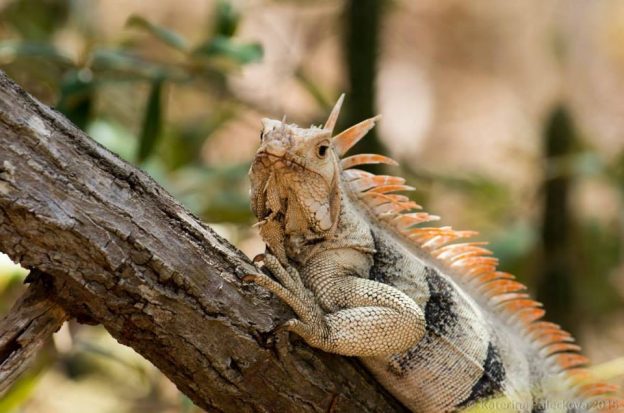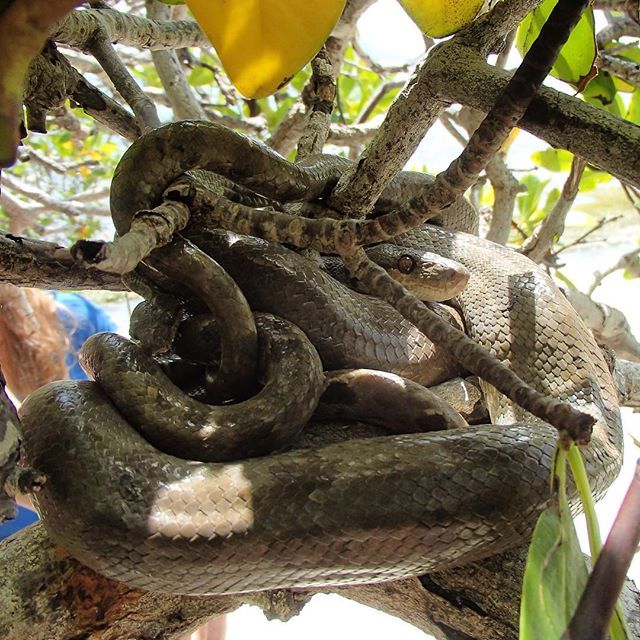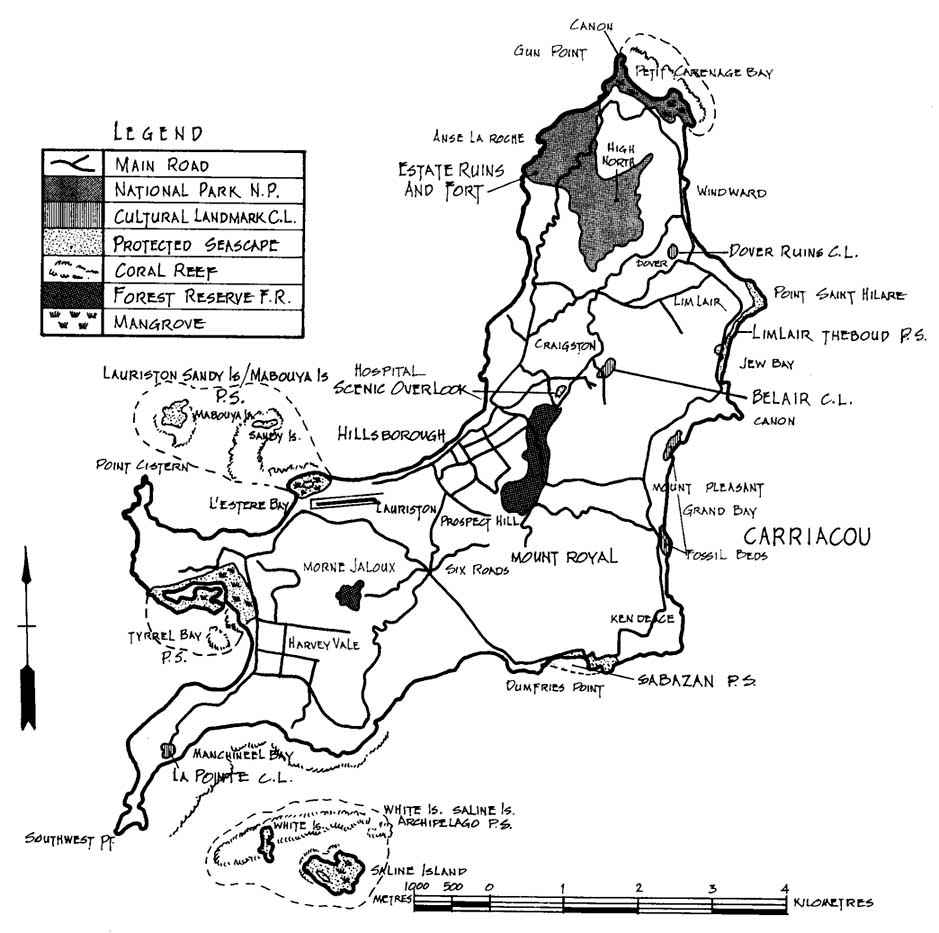Grenada National Parks.
A system of national parks and protected areas is being developed in Grenada and Carriacou, and to date approximately 17% of the tri-island state has been dedared national park land.
The focal point of the system is the Grand Etang National Park, which covers more than 3,800 acres.
Grand Etang National Park is located eight miles from the capital, St. George’s, in the central mountain range.
The Grand Etang lake is the focal point of the reserve and is the crater of an extinct volcano; the lake covers about 30 acres and is surrounded by lush tropical rain forest, at 1,740 feet.
An interpretation and visitor centre overlooking the lake has videos, exhibitions and explanations of the medicinal plants in the forests, and the centre also provides information on treks and walks in the area as well as a fantastic introduction to the island’s wildlife, vegetation, forestry, history and culture.
The area boasts a number of different ecological subsystems ranging from rainforest to elfin woodland and cloud forests higher up.
The flora and fauna around the lake is diverse. A series of trails have been developed which are well worth the effort for the beautiful forest and views, but can be muddy and slippery after rain.
Levera National Park on Grenada.
Maps of the trails are available at the visitor and interpretation centre for a small fee.
Levera National Park was opened in 1994 in the north east of Grenada and is a 450 acre park.
The park includes Levera Pond, beautiful beaches and includes a bird sanctuary and sites of historic interest.
There is a visitor centre where maps of the Park can be had for a small fee.
Levera is one of the island’s largest mangrove swamps, and the marine life and coral around Levera are also spectacular.
Between April and June, leatherback turtles come ashore on the white sand beaches to lay their eggs. Levera Pond is an important breeding and feeding area for waterfowl and other migrant birds and the scarlet ibis is an occasional visitor.
Lake Antoine National Landmark.
Six miles north of Grenville lies another crater lake, Lake Antoine, which occupies 18 acres and is sunken to only about 20 feet above sea level.
This lake offers excellent bird watching opportunities, with snail kite, fulvous whistling duck, large-billed seed-finch, grey kingbird and limpkin.
River Sallee Boiling Springs near Lake Antoine are noted for their unique geology and for being a natural wishing well.
There are both dear and sulphurous boiling springs.
La Sagesse Protected Seascape: A peaceful refuge which boasts three idyllic beaches, a mangrove estuary, a salt pond and coral reefs.
The salt pond attracts brown-crested flycatchers, coots, herons and northern jacuna. In the coastal woodland are the remains of sugar milling and rum distilleries.
Good snorkelling and swimming are available, as well as a guesthouse and restaurant.
Bay Gardens in the suburbs of St. Paul’s have over 5,000 species of plants.
There is a small admission fee but it is well worth it for the conducted tour.
The Gardens are open daily from Monday to Saturday.
Laura’s Herb & Spice Gardens are well worth a visit as one can learn about all the medicinal herbs and spices available on the island, and see them grown in their natural environment. There is a small entrance fee and tours are available Monday to Friday.
Gouyave and Grenville Nutmeg Processing Stations are the largest nutmeg processing factories on the island.
Grenada is the second largest producer of nutmegs in the world, accounting for about a third of the world’s supply! Grenada also produces more spices per square foot than any other place in the world.
Extensive tours of the entire process of nutmeg and mace preparation are available for a small fee.
River Antoine Rum Distillery is the oldest working rum distillery in the Caribbean and the sugar cane is still crushed by machinery operated by a water wheel.
Little has changed since it was opened in the 18th Century.
The distillery is open daily for visits and tastings.
Dougaldston Spice Plantation just outside Gouyave can also be visited where spices are processed and prepared for shipping.
You can learn about dove, cocoa, calabash, turmeric, vanilla, nutmeg and coffee.
Carlton Cocoa Fermentary: Visitors can see how cocoa is processed before being exported and turned into chocolate.
Tours are available Monday to Saturday.
Belvidere Estate: Where almost every plant and crop on the island can be seen, including the breadfruit introduced by Captain Bligh.
The island’s first nutmeg was also planted here, and most of the bananas are cultivated here also.
There are plans to further develop this area as an ecotourism attraction.
Carib’s Leap is a steep cliff face descending vertically into the sea for over 100 feet and is where the last Carib Indians fell to their death in 1651, preferring this to domination by the French.
Mt. Rich Amerindian Remains: The petroglyphs that depict the daily life of Grenada’s earliest inhabitants.
Mabuya Fishermen’s Museum: Just before the fishing village of Gouyave, see an amazing exhibition of articles associated with the sea.
Woburn: A small fishing village to the South of the island, also known as ‘Conch Village’ has one of the rarest sights on the island – The Conch Mound.
This mound comprises millions upon millions of conch shells piled high on top of each other.
Waterfalls.
Annandale Falls are 15 minutes from St. George’s and provide recreational facilities and excellent scenic views.
Concord Falls: Within the Concord Valley are three beautiful waterfalls and are ideal for swimming.
- The first, Concord Falls is accessible by road.
- The second Au Coin.
- The third waterfall is called Fontainbleu.
These waterfalls are accessible only by foot.
At Fontainbleu the water cascades from 65 feet to form a dear water pool.
Marquis Falls also known as the Royal Mt. Carmel Falls, is the highest waterfall in Grenada. It consists of two falls cascading over 70 feet.
Improved access and facilities are underway and this fall won an Eco-Tourism Award from Islands magazine.
Rosemount Falls: A small, private and secluded waterfall, located in the Parish of St. John. The falls are only available to persons lunching at the Rosemount Plantation House.
Seven Sisters Falls consists of seven waterfalls and are a 30 minute trek to the first fall.
To visit all falls takes about one hour, but a good guide is essential.
The falls are some of the most pristine and tranquil on the island.
Victoria Falls situated in the parish of St. Mark at the foothill of Mt. St. Catherine on the West coast.
This unspoilt recently discovered waterfall consisting of two landings, is accessible by foot only.
Marquis Island, Glover Island and Caliviny.
At one time part of the mainland, Marquis Island now has eel grass marine environments and coral reefs.
Nearby is La Baye Rock, which is a nesting ground for brown boobies, habitat for large iguanas, and has dry thorn scrub forest.
It is surrounded by coral reef.
Caliviny mangrove swamp supports a seabird colony and numerous seabirds nest on Glover island.
Flora and Fauna on Grenada.
Fruit trees include,mangoes, plums, golden apples,cashews, oranges, limes, grapefruits, guavas,papaya, soursop, etc.
FAUNA:
The animal life in Grenada consists of frogs, lizards, iguana, armadillo (tatoo), mongooses, snakes and manicou (possum).
None of the island’s snakes are poisonous.
One oddity though is a troop of Mona monkeys, imported from Africa over 300 years ago, which live in the tree tops in the vicinity of Grand Etang.
Birdwatching: 150 species of birds have been identified in Grenada in and Carriacou. The avifauna is primarily tropical North American.
All wild birds and their eggs are given absolute protection throughout the year, with the exception of 19 species from which there is an open season from September to February.
The only endemic bird is the Grenada Dove, which is one of three species of endangered birds.
The other two are the Grenada hookbilled kite or snail hawk, and Euler’s flycatcher.
Typical birds are: the emerald-throated hummingbird, yellow-billed cuckoo, red-necked pigeon, ruddy quail-dove, cocoa thrush, chicken hawks, yellow breasted bananaquits, ducks, waders, and waterfowl.
Over 100 migratory species are regularly recorded and the scarlet ibis is an occasional visitor.
Whale Watching: Humpback whales are often sighted from January to March off the south coast of Grenada Bank.
Dolphins and sometimes pilot whales are sighted off Grenada.
In Carriacou humpbacks are often seen between December and April as well as various dolphins (porpoises), like Spinners, Spotted, Common and Bottlenose, and Pilot and Sperm Whales year-round.
Starwind Enterprises (Tel: 440-3678) are currently the only company offering Whale and Dolphin Watching.
Hiking: Most of the hiking is done within the Grand Etang National Park.
The Morne La Baye nature trail is only 15 minutes long, the Shoreline trail around the lake takes 1 ½ hours and is moderately easy, much further, 1 ½ hours walk is Mount Qua Qua.
The trail then continues for an arduous three hours to Concord Falls, with an extra 30 minutes walk to Fedon’s Camp.
The camp is a Historical Landmark, dating back to 1795 and is located at 2,509 feet.
Seven Sisters trail is approximately one hour, which leads past seven waterfalls. For the more advanced trails, guides are recommended and can be booked through hotels.
Diving: Grenada and Carriacou’s underwater scenery is some of the best in the Caribbean, with a unique feature of a submarine volcano! For further information, please request a copy of ‘Diving-Beneath the Surface’.



